Mosque-Madrassa of Sultan Hassan
| Mosque-Madrassa of Sultan Hassan | |
|---|---|
 Looking down from the Citadel at the Mosque of Sultan Hasan 2014 | |
| Basic information | |
| Location | Cairo, Egypt |
| Affiliation | Islam |
| Architectural description | |
| Architectural type | Mosque |
| Architectural style | Mamluk |
| Completed | 1359 |
The Mosque-Madrassa of Sultan Hassan is a massive Mamluk era mosque and madrassa located near the Citadel in Cairo. Its construction began 757 AH/1356 CE with work ending three years later "without even a single day of idleness".[1] At the time of construction the mosque was considered remarkable for its fantastic size and innovative architectural components. Commissioned by an-Nasir Hasan, a sultan of a short and relatively unimpressive profile, al-Maqrizi noted that within the mosque were several "wonders of construction".[1] The mosque was, for example, designed to include schools for all four of the Sunni schools of thought: Shafi'i, Maliki, Hanafi and Hanbali.
Sultan Hasan
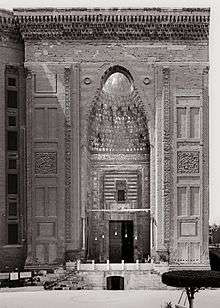
The Mosque of Sultan Hasan is one of the largest mosques in the world, measuring 150m in length and covering an area of 7,906 sq m. Its walls rise to 36m and its tallest minaret to 68m. Visitors enter the complex through a tall portal that is itself a work of art. A dark and relatively low-ceilinged passageway leads to the brightly lit sahn, a standard cruciform-plan open courtyard. The courtyard centers on a domed ablutions fountain, which was probably an Ottoman addition. Soaring on four sides of the courtyard are vaulted liwans (sitting rooms), accented by hanging lamp chains and red-and-black rims.
Each liwan is devoted to one of the four Sunni schools of jurisprudence. Skilfully fitted between and behind each liwan is a madrasa, complete with its own courtyard and four stories of cells for students and teachers. low profile seems inconsistent with the massive undertaking that was his mosque, but the mosque's grandeur makes sense given Sultan Hasan's dramatic life. Sultan Hasan ascended the throne at the age of 13 in 748 AH/1347 CE.[2] When he reached maturity in 1350, he arrested the Emir Manjaq who controlled all of the state's affairs. Prior to that arrest, the emir was restricted to an allowance of just one hundred dirham per day. This pocket change was collected by servants for the Sultan. It's especially striking considering that during that time, the emir Shaykhu was estimated to have an income of 200,000 dirham per day. This deprivation may be viewed as a prompt for his later extravagance.


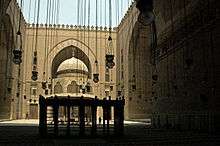
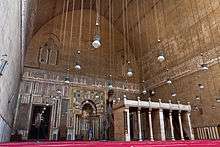
Upon taking over the reins, Sultan Hasan placed people of his own favor into positions of power. This happened at the expense of dignitaries currently in position; it upset many of them. Discontented Emirs arrested the Sultan in 1351, held him in jail for three years, and promoted his brother as-Salih Salih to the throne. Hasan spent his time in jail studying and his obituaries commented on his learning as a result.[2]
He returned to power and again reshuffled the ruling establishment attempting to solidify power, but Sultan Hasan was assassinated by his commander in chief of the army, Yalbugha al-Umari, a Mamluk thought to be loyal.[2] Because of the Sultan's extravagance in spending fortunes on women and other forms of favoritism, the commander rebelled against the Sultan. A contemporary Syrian historian, Ibn Kathir, backed this reputation.[2] Ibn Kathir blamed the sultan for his greed and squandering of public funds. The lavish expenses noted coincide with the Sultan's extensive mosque. After his assassination, Sultan Hasan's body was hidden and never found; the mosque never served its purpose.
The construction of the mosque
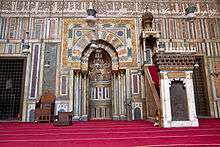
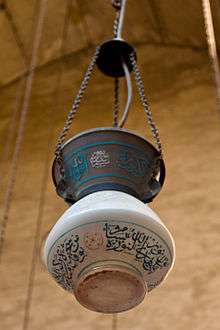

Little information is available about the construction of the mosque of Sultan Hasan. The most substantial source available is al-Maqrizi writing six decades later. He had access to administrative documents that are unavailable to historians today. Maqrizi mentions that the construction of the mosque cost 30,000 dirham every day, making it the most expensive mosque in medieval Cairo.[1] Financing for the mosque was paid for by the austerity of Manjaq, by Shaykhu's wealth, and by extortion from subjects. Even the Sultan may have considered the mosque of too great an expense. Al-Maqrizi noted that a eunuch said he heard the Sultan say "if it were not that the king of Egypt would be called incapable of finishing a building that he had started, then I would stop building this mosque on account of the greatness of what is spent on it".
An inscription on the mosque notes the name of emir Mohammed ibn Biylik, the supervisor of the construction of the mosque. Unusually his name was placed near Sultan Hasan's in the inscription.[2] Placing the supervisor's name alongside the patron's demonstrated how massive an undertaking the mosque was. The emir's high standing otherwise was another indication of this prestige. Mohammed was involved in the construction of several other important structures in Cairo including the Hippodrome. Other labor for the mosque might have been restricted by the population loss of the Black Death, but as this was such a large undertaking, it attracted craftsmen from all over the Mamluk Empire.
The construction of the minarets is of particular interest. Plans called for four minarets, but only three were ever constructed. One of the minarets collapsed and three hundred people were killed. Al-Maqrizi noted that the minaret's fall ignited conversation across Cairo and Fustat about the impending downfall of the state. Al-Maqrizi noted also that a poet wrote lines in response that said that the fall of the minaret meant that God was present in it. The conversations in the public came to fruition. Sultan Hasan's assassination followed the minaret's fall by thirty-three days. Construction of the mosque continued after the Sultan's death, but it still was never completed.
The mosque itself
The mosque was built close to the Citadel, on the site of the Palace of Yalbugha al-Yahawws. This was meant as a pleasing site for the Sultan to look down on from his palace in the Citadel. During the medieval era, an open space connected the mosque and the Citadel.[3] This proximity and the mosque's sturdiness gave the mosque a unique strategic significance. Ibn Ilyas reported that it was used by Mamluk rebels as a fort to attack the Citadel from. Al-Maqrizi, noted that "as soon as there occurred strife between the people the state, a number of amirs and others ascended to the top of the mosque and began to bombard the Citadel from there".[1] For this reason, the Sultan Janbulat tried to demolish the mosque, but after three days of attempted demolition, he had little success and gave up. Al-Maqrizi noted that the Sultan Barquq demolished the stairs to the two minarets to make it less useful in attacks against the citadel.
The sheer size of the mosque set it apart. Al-Maqrizi noted that the height of the large iwan was superlative. It measured 65 cubits, five higher than another notably large mosque, the Iwan of Kusraw at Al-Mada'in in Iraq.[1]
Several unique features about the mosque should also be noted. Al-Maqrizi noted that the great dome that was not equaled in Egypt, Syria, the Maghreb, or Yemen. Despite the thickness of the mausoleum walls, the dome was made of wood. The mosque's dome was of an uncommon shape, that of an egg. The positioning of the mausoleum between two minarets was quite novel. Four minarets were planned, but they were never completed. This was an exceptional number for a mosque. The design of the twin portal minarets was uncommon as was the gigantic size of the mosque. The mosque is the only instance of chinoiserie in Mamluk architecture.[2] The setup of the mosque was novel as well. The mausoleum was placed directly behind the prayer hall. This might have been thought profane, but it was not at the time.
See also
References
- 1 2 3 4 5 Martyn, Smith. "Khitat 2:316-17". Retrieved 9 March 2011.
- 1 2 3 4 5 6 Behrens-Abouseif, Doris (2007). Cairo of the Mamluks : a history of the architecture and its culture (null ed.). London: I.B. Tauris. pp. 201–213. ISBN 978-1-84511-549-4.
- ↑ Martyn, Smith. "Rumayla". Retrieved 9 March 2011.
External links
| Wikimedia Commons has media related to Mosque of Sultan Hasan. |